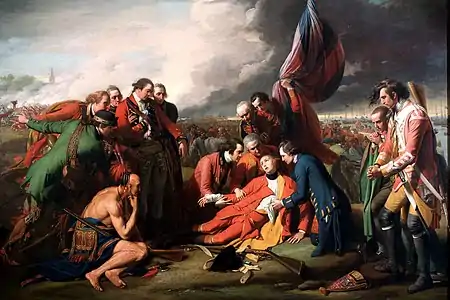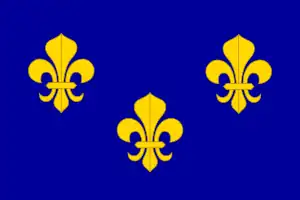| |||||
| Decades: |
| ||||
|---|---|---|---|---|---|
| See also: | |||||
| Part of a series on the |
| History of Canada |
|---|
 |
| Timeline (list) |
| Historically significant |
| Topics |
| By provinces and territories |
| Cities |
| Research |
Events from the year 1749 in Canada.
Incumbents
Governors
- Governor General of New France: Roland-Michel Barrin de La Galissonière then Jacques-Pierre de Taffanel de la Jonquière, Marquis de la Jonquière
- Colonial Governor of Louisiana: Pierre de Rigaud, Marquis de Vaudreuil-Cavagnial
- Governor of Nova Scotia: Edward Cornwallis
- Commodore-Governor of Newfoundland: George Brydges Rodney
Events
- Halifax, capital of Nova Scotia, is founded by British General Edward Cornwallis to counter French presence at Louisbourg.
- La Vérendrye was awarded the cross of Saint Louis, in honour of his career.
- French agricultural settlement established in what would become Windsor, Ontario.
Births
Full date unknown
- Joel Stone, founder of Gananoque, Ontario (died 1833)
Deaths
- December 5 - Pierre Gaultier de Varennes, sieur de La Vérendrye, French Canadian military officer, fur trader and explorer (born 1685).
Historical documents
Brief rundown of religious orders in Canada and "the duties of their ministries" in healthcare and education[3]
European visitor describes the character of French Canadian women[4]
From Quebec City, Pehr Kalm writes to Benjamin Franklin about impressive welcome given Marquis de la Jonquière, new Governor General[5]
Upper class lady says priests have ordered Ladies of the Holy Family who caused scandal over dancing to do penance[6]
Madame Bégon quotes someone as saying it's "foolish to remain in a country where all of the money goes towards keeping oneself warm"[7]
Ambassador to France to "make remonstrances" about Canadians trying to move into Saint John River lands and debauch Six Nations prisoners[8]
Decision to "settle and fortify" Nova Scotia based on need to counter Louisbourg, and for trade and fishery[9]
Notice to recently discharged war veterans, plus tradesmen and surgeons, to take up land, arms, tools and one year's subsistence in Nova Scotia[10]
Settler describes voyage, arrival and establishment of hundreds of settlers under Gov. Cornwallis at Chebucto[11]
Cornwallis promises Acadians can still exercise their religion and keep their lands if they take oath of allegiance and obey orders[12]
Nova Scotia Council unanimously rejects Acadian request for exemption from wartime service and sets mid-October deadline for oath-taking[13]
Acadians forbidden to sell or take property if they chose to leave and will lose possessions and rights if they miss oath deadline[14]
"We are resolved, everyone of us, to leave the country" - Strong emotion revealed in Acadian plea to live under old oath's terms[15]
Leaders of First Nations in Chignecto and on Saint John River renew Peace and Friendship Treaty of 1725[16]
Canadians and Indigenous people "have made some small appearances to intimidate our new settlers" in Minas, Chignecto and Chebucto[17]
More troops needed, what with "a number of Indians a declared Enemy" and "Accadians certainly more Friends to the French than us"[18]
"I [lack] any sanguine Expectation as to the Success of this New Colony" - In a word, hostilities (Note: scalping described)[19]
"Far exceeds any idea I could possibly have of it" - Newcomer very pleased with climate, soil, game and leadership of Halifax[20]
Illustration of Halifax, drawn from high up on ship's mast (Note: gallows depicted)[21]
French evidence of British policy of new settlement in Nova Scotia breaking agreement with France to fix its borders (Note: "savages" used)[22]
Annapolis Royal houses burned to better protect fort, but "Soldiers [who] cannot be kept within due Bounds" burn too many of them[23]
Description of Indigenous people in Nova Scotia includes story involving Chief Membertou (Note: racial stereotypes)[24]
Indigenous hunting season in what is now Nova Scotia ranges from elk to sea wolf to eggs of turtles and birds[25]
Hudson's Bay Company undercuts its trade by making Indigenous people come to Bay posts and offering worse deals than French do[26]
Ending Hudson's Bay Company's monopoly on trade in territory it claims could increase British exports from £3,600 to £200,000 annually[27]
Explorer describes clues on Hudson Bay that indicate nearness of "western sea" and existence of Northwest Passage[28]
References
- ↑ Guéganic (2008), p. 13.
- ↑ "George I". Official web site of the British monarchy. 30 December 2015. Retrieved 18 April 2016.
- ↑ "Memorandum of instructions to Sieur de La Jonquière" (translation; April 30, 1749), France Archives nationales. Accessed 19 July 2021
- ↑ Pehr Kalm, Travels into North America; Vol. III (London, 1771), pgs. 55-7. (See brief remark on prostitutes and Kalm's description of Quebec City convent) Accessed 7 October 2017
- ↑ "To Benjamin Franklin from Peter Kalm, 6 August 1749" U.S. National Archives. Accessed 23 November 2021
- ↑ Élisabeth Rocbert de la Morandière, dite Madame Bégon, March 6, 1749 letter excerpt Archives nationales du Québec. Accessed 15 November 2021
- ↑ Élisabeth Rocbert de la Morandière, dite Madame Bégon, April 27, 1749 letter excerpt Archives nationales du Québec. Accessed 15 November 2021
- ↑ "Bedford to Albemarle" (August 17, 1749), British Diplomatic Instructions; 1689-1789; Volume VII, France, Part IV, 1745-1789, pg. 7. Accessed 15 November 2021
- ↑ John Entick et al., "Cape Breton having been given back" The General History of the Late War; Vol. I (1763), pgs. 16-17. Accessed 1 December 2021
- ↑ "Proposals" (March 7, 1748-9), A Genuine Account of Nova Scotia[...]to which is Added[...]Proposals, as an Encouragement to those who are willing to settle there, pgs. 12-14. Accessed 8 November 2021 (See details and comments on this settlement plan)
- ↑ Settler's letter (July 28, 1749), quoted in French Policy Defeated (1755), pg. 30ff. Accessed 17 November 2021
- ↑ "A Declaration" (Govr. Cornwallis' Letter Book; July 14, 1749), Nova Scotia Archives; Acadian French, pgs. 165-6. (See also Council decision to require oath without reservation) Accessed 18 November 2021
- ↑ "Minutes of a Council held on board The Beaufort" (July 31, 1749), Nova Scotia Documents; Acadian French, pgs. 168-9. Accessed 18 November 2021
- ↑ Council meeting (August 1, 1749), Nova Scotia Documents; Acadian French, pg. 170. Accessed 18 November 2021
- ↑ Council meeting (September 6, 1749), Nova Scotia Documents; Acadian French, pg. 170. (See Cornwallis's stern reply) Accessed 18 November 2021
- ↑ 1749 Renewal at Chebucto of the Treaty of 1725 (August 15, 1749), Nova Scotia Archives. (See also ratification signed on September 4, 1749) Accessed 19 November 2021
- ↑ William Douglass, "the French Coureurs des Bois and their Indians" A Summary, Historical and Political, of the[...]British Settlements in North-America; Vol. II, pg. 7. (See report of one attack) Accessed 17 November 2021
- ↑ "Colonel Edward Cornwallis to Robert Napier" (December 6, 1749), Military Affairs in North America; 1748-1765 (1936), pgs. 8-9 (PDF pgs. 44-5). Accessed 19 November 2021
- ↑ John Wilson, "In a Word" A Genuine Narrative of the Transactions in Nova Scotia, Since the Settlement, June 1749[....], pgs. 9-21. Accessed 16 November 2021
- ↑ "Extract of a letter from Chebucto harbour, Nova Scotia, August 17" Historical Chronicle, October 1749. Accessed 15 November 2021
- ↑ "A View of Halifax Drawn from ye Topmasthead" (published January 25, 1750), Nova Scotia Archives. Accessed 19 November 2021
- ↑ "It was immediately upon the Back of this Peace" A Memorial Containing A summary View of Facts[...]in Answer to The Observations [of] the English Ministry[...]; Translated from the French (1757), pgs. 3-5ff. Accessed 16 November 2021
- ↑ Council minutes (January 24, 1748/9), Nova Scotia Archives; Minutes of H.M. Council, 1736-1749, pgs. 99-100. Accessed 18 November 2021
- ↑ "The Indian Natives of the Peninsula" A Geographical History of Nova Scotia (1749), pgs. 42-53. Accessed 16 November 2021
- ↑ A Geographical History of Nova Scotia (1749), pgs. 48-9, 98-9. Accessed 11 January 2021
- ↑ "Report from the Committee on the State of The Hudson's Bay Company" (April 24, 1749), pgs. 216, 217-19, 223, 226, 229, 231-4. Accessed 5 January 2021
- ↑ A Short State of the Countries and Trade of North America Claimed by the Hudson's Bay Company (1749). (See rundown of several arguments against HBC) Accessed 16 November 2021
- ↑ Henry Ellis, "The Third Part: Comprehending, Such Arguments(...)as serve to shew the great Probability of a Passage by the North West(...)" A Voyage to Hudson's-Bay, by the Dobbs Galley and California, In the Years 1746 and 1747[....] (1749), pgs. 136-47. Accessed 11 January 2021
.svg.png.webp)
